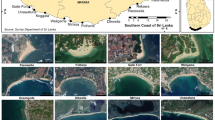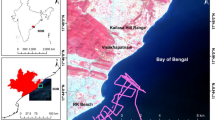Abstract
Shoreline change analysis frequently begins with feature identification through visual interpretation (proxy-based shoreline) or the intersection of a specific tidal zone (datum-based shoreline). Using proxy-based shoreline information, this study quantifies the distance between proxy-based and datum-based shoreline data, which is defined as the proxy-datum bias. The study was conducted at meso-tidal beaches in Kuala Nerus, Terengganu, Malaysia, with morphodynamic responses to northeast and southwest monsoons. The high-water line (HWL) shoreline (proxy-based) was determined using ortho-rectified aerial images captured by an unmanned aerial vehicle (UAV). By contrast, the mean high-water (MHW) shoreline (datum-based) was determined using measured beach profiles adjusted with the Peninsular Malaysia Geodetic Vertical Datum (DTGSM). The theoretical proxy-datum bias was approximated using the best estimate (median) for the beach slope, wave height, and wave period from the estimated total water level (TWL) model. Based on the study, the recorded horizontal proxy-datum bias for the research area was up to 32 m. This study also discovered that the theoretical assumption of the proxy-datum bias based on the TWL model yields values comparable to those of the measurements, with a narrower distinction in bias for steeper beach slopes than the obtained results. The determined proxy-datum bias value can benefit future shoreline change studies as it could be incorporated to either proxy-based shorelines by shifting the shoreline seaward or to datum-based shorelines by shifting the shoreline landward in order of the bias value. The seasonal monsoon’s effect on beach profiles should be considered when calculating bias values and conducting potential shoreline change rate studies.
Similar content being viewed by others
References
Ariffin EH, Sedrati M, Akhir MF, Yaacob R, Husain ML (2016) Open sandy beach morphology and morphodynamic as response to seasonal monsoon in Kuala Terengganu, Malaysia. Journal of Coastal Research 75: 1032–1036
Ariffin EH, Sedrati M, Akhir MF, Daud NR, Yaacob R, Husain ML (2018) Beach morphodynamics and evolution of monsoon-dominated coasts in Kuala Terengganu, Malaysia: Perspectives for integrated management. Ocean and Coastal Management 163: 498–514
Ariffin EH, Sedrati M, Daud NR, Mathew MJ, Akhir MF, Awang NA, Husain ML (2019) Shoreline evolution under the influence of oceanographic and monsoon dynamics: the case of Terengganu, Malaysia. Coastal Zone Management, 1st edition, 113–130
Berrisford P, Dee D, Fielding K, Fuentes M, Kallberg P, Kobayashi S, Uppala S (2009) The ERA-Interim archive. ERA Report Series. 1. Technical Report. European Centre for Medium-Range Weather Forecasts, pp16. Available from: https://www.ecmwf.int/en/elibrary/8174-era-interim-archive-version-20 [Accessed on Sep. 15, 2020]
Boak EH, Turner IL (2005) Shoreline definition and detection: a review. Journal of Coastal Research 214: 688–703
Borrelli M, Boothroyd JC (2020) Calculating rates of shoreline change in a coastal embayment with fringing salt marsh using the “marshline”, a Proxy-based shoreline indicator. Northeastern Naturalist 27(sp10): 132–156
Cohen O (2016) Profiler 3.2 XL: Mode d’emploi. New Caledonia, 48
Crowell M, Leatherman SP, Buckley MK (1991) Historical shoreline change: error analysis and mapping accuracy. Journal of Coastal Research 7(3): 839–852
Department of Irrigation and Drainage, Malaysia (2015) National coastal erosion study (NCES). Available from http://nces.water.gov.my/nces [Accessed on Feb. 15, 2021]
Jaharudin P, Kamarul MD, Abu TJ, Haslina M, Pravinassh R (2019) Impact of coastal erosion on local community: Lifestyle and identity. Disaster Advances 12(2): 19–27
Jayson-Quashigah P, Appeaning AK, Amisigo B, Wiafe G (2019) Assessment of short-term beach sediment change in the Volta Delta coast in Ghana using data from Unmanned Aerial Vehicles (Drone). Ocean and Coastal Management 182: 104952. DOI: https://doi.org/10.1016/j.ocecoaman.2019.104952
Kraus NC, Rosati JD (1997) Interpretation of shoreline-position data for coastal engineering analysis. Coastal Engineering Research Center. Available from https://erdc-library.erdc.dren.mil/jspui/bitstream/11681/2118/1/CETN-II-39.pdf [Accessed on Sep. 26, 2021]
Liu X, Xia J, Wright G, Arnold L (2014) A state of the art review on High Water Mark (HWM) determination. Ocean and Coastal Management 102(PA), 178–190
Liu Y, Zheng X, Ai G, Zhang Y, Zuo Y (2018) Generating a high-precision true digital orthophoto map based on UAV images. Canadian Historical Review 7(9): 333
Mancini F, Dubbini M, Gattelli M, Stecchi F, Fabbri S, Gabbianelli G (2013) Using unmanned aerial vehicles (UAV) for high-resolution reconstruction of topography: The structure from motion approach on coastal environments. Remote Sensing 5(12): 6880–6898. https://doi.org/10.3390/rs5126880
Mathew MJ, Sautter B, Ariffin EH, Menier D, Ramkumar M, Siddiqui NA, Gensac E (2020) Total vulnerability of the littoral zone to climate change-driven natural hazards in north Brittany, France. Science of the Total Environment 706: 135963
Mohamad N, Ahmad A, Md Din AH (2021) Estimation of surface elevation changes at bare earth riverbank using differential DEM technique of UAV imagery data. Malaysian Journal of Society and Space 17(4): 339–352. DOI: https://doi.org/10.17576/geo-2021-1704-23
Moore LJ, Ruggiero P, List JH (2006) Comparing mean high water and high water line shorelines: should proxy-datum offsets be incorporated into shoreline change analysis? Journal of Coastal Research 224: 894–905
Muslim AM, Ismail KI, Khalil I, Razman N, Zain K (2006) Detection of shoreline changes at Kuala Terengganu, Malaysia from multi-temporal satellite sensor imagery. 34th International Symposium on Remote Sensing of Environment, Sydney, Australia, 4
Pujianiki NN, Antara ING, Temaja IGRM, Partama IGDY, Osawa T (2020) Application of UAV in rip current investigations. International Journal on Advanced Science Engineering Information Technology 10(6): 2337–2343
Ruggiero P, Gelfenbaum G, Kaminsky GM (2003) Linking proxy-based and datum-based shorelines on a high-energy coastline: implications for shoreline change analyses. Journal of Coastal Research 38: 57–82
Ruggiero P, List JH (2009) Improving accuracy and statistical reliability of shoreline position and change rate estimates. Journal of Coastal Research 255: 1069–1081
Sallenger AH, Krabill WB, Swift RN, Brock JC, List JH, Hansen M, Holman RA, Manizade S, Sontag J, Meredith A, Morgan K, Yunkel JK, Frederick EB, Stockdon H (2003) Evaluation of airborne topographic LIDAR for quantifying beach changes. Journal of Coastal Research 19(1): 125–133
Selamat NS, Abdul Maulud KN, Mohd FA, AB Rahman AA, Zainal MK, Abdul Wahid MA, Awang NA (2019) Multi method analysis for identifying the shoreline erosion during northeast monsoon season. Journal of Sustainability Science and Management 14(3): 43–54
Shoab M, Singh VK, Ravibabu MV (2022) High-precise true digital orthoimage generation and accuracy assessment based on UAV images. Journal of the Indian Society of Remote Sensing 50(4): 613–622. https://doi.org/10.1007/s12524-021-01364-z
Stockdon HF, Holman RA, Howd PA, Sallenger AH (2006) Empirical parameterization of setup, swash, and runup. Coastal Engineering 53(7): 573–588. https://doi.org/10.1016/j.xoastaleng.2005.12.005
Stockdon HF, Sallenger AH, List JH, Holman RA (2002) Estimation of shoreline position and change using airborne topographic lidar data. Journal of Coastal Research 18(3): 502–513
Subiyanto S, Ihsan YN, Rizal A, Supian S, Ahmad MF, Sambas A, Mamat M, Non AT (2019) Numerical simulation for shoreline erosion by using new formula of longshore sediment transport rate. Proceedings of the International Conference on Industrial Engineering and Operations Management, Bangkok, Thailand 1564–1572
Vellemu EC, Katonda V, Yapuwa H, Msuku G, Nkhoma N, Makwakwa C, Safuya K, Maluwa A (2021) Using the Mavic 2 Pro drone for basic water quality assessment. Scientific African 14(3): e00979
Zhang K, Chen SC, Whitman D, Shyu ML, Yan J, Zhang C (2003) A progressive morphological filter for removing nonground measurements from airborne LIDAR data. IEEE Transactions on Geoscience and Remote Sensing 41(4 PART I): 872–882. https://doi.org/10.1109/TGRS.2003.810682
Zulfakar MSZ, Akhir MF, Ariffin EH, Awang NA, Yaacob MAM, Chong WW, Muslim AM (2020) The effect of coastal protections on the shoreline evolution at Kuala Nerus, Terengganu (Malaysia). Journal of Sustainability Science and Management 15(3): 71–85
Acknowledgement
Supported by the Internal Grant of Universiti Malaysia Terengganu under the Translational Research Grant No. Vot 53464.
Author information
Authors and Affiliations
Corresponding author
Additional information
Article Highlights
• Shoreline change analysis can be identified based on visual interpretation or through identification of intersection on a specific tidal zone.
• Theoretical and measured values of the horizontal distance between proxy-based and datum-based shoreline data is quantified.
• Theoretical estimates of the proxy-datum bias is comparable to measurement values with a reasonably small disparity in steeper beach.
Rights and permissions
About this article
Cite this article
Nasir, F., Roslee, A., Zakaria, J. et al. Shoreline Identification Bias: Theoretical and Measured Value for Meso-Tidal Beaches in Kuala Nerus, Terengganu (Malaysia). J. Marine. Sci. Appl. 21, 184–192 (2022). https://doi.org/10.1007/s11804-022-00293-8
Received:
Accepted:
Published:
Issue Date:
DOI: https://doi.org/10.1007/s11804-022-00293-8




